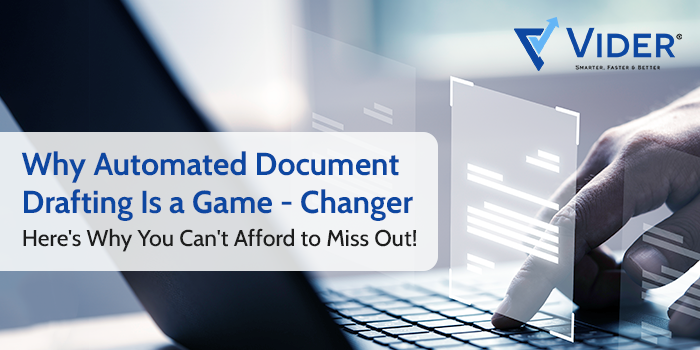
A time waster for some, a source of headache for others, and a workflow stumbling block for many – manual document drafting is notorious for being a universally disliked chore.
And the most frustrating part? The cumulated hours of time and efforts spent in manual drafting don’t free you from errors and inaccuracies.
Even when manual drafting is done with great care, it often fails to yield efficient results. According to an IDC survey, these document challenges cause a 21.3% drop in productivity. The inefficiency and productivity drain caused by tedious manual document drafting is evident in the following:
Time Wastage: Employees spend valuable time recreating boilerplate text, adjusting layouts, and making customizations manually.
Costly Errors: Typos and inconsistencies, particularly in critical areas like legal and finance documents, can result in expensive mistakes and delays.
Version Control Nightmare: Managing multiple document versions is a chaotic process, made worse by the challenge of revising them promptly.
There’s got to be a better way; strike that—there is a better way.
Automated Document Drafting: Your Hero in Disguise
Legal contracts, proposals, HR documents, compliance and policy documents, licensing, lease or partnership agreements, NDAs, and more – documentation is fundamental to every business, irrespective of the industry.
While this documentation is essential, it’s also the bane of every business. Constructing new documentation from the ground up consumes a significant portion of knowledge workers’ days, often becoming a source of bottlenecks and costly errors. Manual documentation drafting burdens a business unless it’s automated.
What is Automated Document Drafting?
Automated document drafting automatically generates electronic documents tailored to specific business and legal needs. This intelligent document creation leverages pre-built templates, standard clauses, existing data, dynamic logic rules, and user-driven data prompts to streamline the process. Here’s how it works:
Pre-built Templates: The standard templates contain pre-written clauses, sections, and boilerplate language relevant to the user’s selected documentation type (NDAs, business proposals, wills, licensing agreements).
Data Prompts: The system gathers relevant and required information from the user through questionnaires or interactive fields.
Automatic Clauses using Dynamic Logic: This is the step where the system’s intelligence comes into play. Based on the users’ inputs, and redefines conditions, the platform automatically:
- Selects and inserts the most appropriate clauses from the library based on the specificity of the documentation.
- Triggers additional prompts based on the specific details provided by the users.
- Tailors adjust the document’s structure and content to match the user’s situation and requirements perfectly.
Thus, the automated document creation process dynamically adapts to the user to provide the closest fit for the specific document requirements.
All these steps are executed seamlessly, facilitating a sophisticated level of customization that unlocks revolutionary benefits, transforming document creation into strategic tools. This seamless document automation resolves issues and delivers exceptional experiences for all stakeholders involved. Here’s how:
Saves Employee Time: Automated document creation liberates employee time by reducing the total time spent on document drafting by 95%. This time can be redirected towards strategic and valuable tasks. Saving time for the employees directly results in improved productivity and resource optimization while enhancing the total ROI for the firm.
No More Errors, Mistakes, or Oversights: Ever heard about the London law firm that faced nearly £2 million in costs due to a contract error? With automation, you no longer need to fear the mistakes creeping into your document drafting. Utilizing pre-built templates and comprehensive error-checking, automated document drafting ensures 100% error-free document generation for your peace of mind.
Streamlines Collaboration and Decision-Making: Document automation fosters seamless collaboration through a centralized platform for sharing and editing documents, enhancing communication and teamwork for improved efficiency. Additionally, a centralized document automation platform simplifies access and organization of the information chain, easing the decision-making process.
Compliance and Risk Mitigation: The pre-built templates are continuously updated with the utmost care to ensure up-to-date documents align with the latest compliance and legal requirements. A competent document automation platform incorporates continuous updates and revisions with multiple compliance checks to ensure complete compliance, particularly with legal document automation and management.
So, Who Can Benefit From Automated Document Creation?
Legal Document Automation: Legal firms can optimize the creation of contracts, agreements, and legal correspondence, ensuring precision and adherence to regulations. Through legal document automation and management, lawyers can reclaim valuable time spent on tedious drafting tasks and redirect it toward more productive endeavors.
Financial Document Automation: Financial enterprises grappling with extensive documentation benefit from streamlined drafting processes that accelerate the generation of reports, statements, and contracts.
Government Document Automation: From routine administrative reports to critical public-facing documents such as tax forms and record requests, automated drafting expedites document creation processes within government agencies, ensuring efficiency and accuracy.
Business Document Automation: Businesses reliant on proposals and contracts experience enhanced sales efficiency through swift and tailored document creation, boosting overall productivity. Additionally, HR document automation is another area where document automation platforms can save significant time, provide value, and enhance user experience.
In short, every organization requiring standardized documentation can derive massive benefits from document automation.
However, it comes down to the specific document automation platforms that can provide the correct value to the organization.
Quantum by Vider: Most Comprehensive Document Automation Platform
Quantum is a centralized document automation platform that automates document generation and facilitates seamless document management with cloud storage. It enables end-to-end document lifecycle management with easy document sharing, collaboration, and approval, all while ensuring security through e-signature facilitation.
From document creation to customization, collaboration, and approval, Quantum streamlines the entire process, ensuring efficiency, accuracy, and security at every step. Know more about our document automation platform here.




